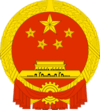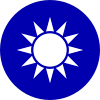The People's Republic of China is commonly known as China and the Republic of China is commonly known as Taiwan. These are separate states with a shared history; China claims sovereignty over Taiwan.
After the Kuomintang reunified China in 1928, most of mainland China was governed by the Republic of China (ROC). The island of Taiwan was under Japanese rule at the time. At the end of World War II in 1945, Japan surrenedered Taiwan to the Republic of China. In 1949, there was a civil war in China and the government (ROC) lost control of mainland China to the Communist Party, which established the People's Republic of China (PRC) and took control of all of mainland China. Only the island of Taiwan remained under the control of the ROC.
Since then, both the ROC and the PRC have been claiming to represent all of "China", and both officially claim each other's territory. In the 1992 consensus, both governments agreed that there is only one "China" but each claimed to be the sole representative of the sovereignty of undivided China. The PRC's (China's) official policy is to reunify Taiwan with mainland China under the formula of "one country, two systems" and refuses to renounce the use of military force, especially if Taiwan seeks a declaration of independence.
In Taiwan political opinion is divided into two camps: the Pan-Blue Coalition (majority Kuomintang) believes that the ROC is the sole legitimate government of "China" but supports eventual Chinese reunification. The opposition Pan-Green Coalition (majority Democratic Progressive Party) regards Taiwan as an independent state and seeks wide diplomatic recognition and an eventual declaration of formal Taiwanese independence.
Comparison chart
| | People's Republic Of China | Republic Of China |
|---|---|---|
| Currency | Chinese Yuan (also called Renminbi) (¥) (CNY) | New Taiwan dollar (NT$) (TWD) |
| Time zone | China Standard Time/Beijing Time (UTC+8) | China Standard Time (UTC+8) |
| Government | Single-party state, nominal communist state | Unitary, Semi-Presidential, Constitutional Republic, Representative Democracy |
| Demonym | Chinese | Taiwanese, Chinese |
| Calling code | +86 | +886 |
| Internet TLD | .cn, .中國, .中国 | .tw, .台灣, .台湾 |
| Drives on the | Right, except for Hong Kong & Macau which drive on the left | Right |
| Capital | Beijing | Taipei, Taiwan (Originally Nanjing, China) |
| President | Xi Jin-ping | Tsai Ing-wen (2016) |
| Description of Flag | Red coloured flag with five yellow coloured stars on the top left side. | White colored sun in the blue colored sky on the top left site with the whole red colored land on the bottom. |
| National Anthem | March of the Volunteers | Zhōnghuá Míngúo gúogē (National Anthem of the Republic of China) |
| Largest city | Shanghai | Taipei, Taiwan |
| Date formats | YYYY/MM/DD | YYYY/MM/DD |
| Preceded by | The Qing Dynasty (expelled Republic of China after civil war) | The Qing Dynasty |
| Official Name | The People's Republic of China (PRC) | Republic of China (ROC) |
| National language | Mandarin Chinese | Chinese |
| Literacy rate | 95.9 % | 98.29 % |
| Official script | Simplified Chinese | Traditional Chinese |
| Current constitution | 1 October 1949 | 25 December 1946 |
| Vice President | Li Yuan -Chao | Chen Chien-jen |
| Official languages | Standard Chinese | Mandarin Chinese, Formosan languages, Taiwanese Hokkien, Hakka Chinese, Taiwanese Mandarin |
| Introduction (from Wikipedia) | China, officially the People's Republic of China (PRC), is a sovereign state in East Asia. It is the world's most populous country, with a population of over 1.35 billion. The PRC is a single-party state governed by the Communist Party | Taiwan is a small island nation 180km east of China with contemporary cities, hot springs resorts and dramatic mountainous terrain. Taipei, the country’s capital in the north, is known for its busy night markets and street-food vendors |
| Regional Divisions | Provinces, Municipalities and special administrative regions. | Provinces , Yuan municipality, Regions and special administrative regions (China). Provinces (been false in 1998), Municipalities (Taiwan). |
| Ethnic Groups | 91.51% Han, 55 Recognised Minorities = 1.30% Zhuang, 0.86% Manchu, 0.79% Uyghur, 0.79% Hui, 0.72%Miao, 0.65% Yi, 0.62% Tujia, 0.47% Mongol, 0.44% Tibetan 0.26% Buyei, 0.15% Korean, 1.05% others | 98% Han, 70% Hoklo, 14% Hakka, 14% Mainlanders, 2% Taiwanese aborigines |
| General political conditions | It is claimed a communist nation but practicing capitalism. | Capitalism. |
| Nobel laureates | 10 | 1 |
| Proclaimed | 1 October 1949 | 1 January 1912 (original republic in China), 7 December 1949 (after the civil war, retreated to Taiwan ) |
| HDI (Human Development Index)(2011) | 0.699 (Medium) | 0.890 (Very High) |
| GDP (PPP) : Per capita | $13,801 (87th) | $47,500 (17th) |
| ISO 3166 Code | CN | TW |
| Christian population | 5.2 % | 4.5 % |
| Muslim population | 1.8 % | 0.2 % |
| Population (2013) | 1,350,695,000 (1st) | 23,445,534 |
| Highest point | Mount Everest (8,848 m) | Yushan (3,952m) |
| Total Area | 9,596,961 km² (China) | 11,418,174 km² (Claims in China), 36,192 km² (Actually in Taiwan) |
| Life expectancy | 75 | 79.98 |
| Poverty threshold | 6.1 % (2013) | 1.5 % (2013) |
| GDP (nominal) : Total | $11.212 trillion (2nd) | $505.452 billion (26th) |
| Religion Freedom | Some not allowed | Yes |
| Density | 142/km² | 640 /km² (Taiwan) |
| Largest city (in population) | Shanghai | Taipei |
| Total length of land border | 22,147 km | 1,566.3 km (Taiwan) |
| GDP growth | 7.4 % | 3.74 % (2014) |
| Total expressways (2012) | 84,946 km | 1019.9 km (Taiwan) |
| GDP (PPP) : Total | $18.976 trillion (1st) | 1,021.607 billion (21st) |
| Population : Density | 145/km2 (83rd) 373/sq mi | 649.25/sq km |
| Flag Colors | Red and Yellow | Blue, White, and Red |
| Buddhist population | 7.8 % | 93 % |
| Area : Total | 9,596,961 km2 (3rd/4th) 3,705,407 sq mi | 13,974 mi² |
| Independence | October 1, 1949 | 1949 |
| Hindu population | 0.01 % | 0.008 % |
| GDP (nominal) : Per capita | $8,391 (75th) | $21,571 (39th) |
| Tallest Building | Shanghai World Financial Center (492 m) | Taipei 101 (509.2 m) |
| Urban population | 51.27 % (2011) | 73 % (2013) |
| Total internet users | 568,192,066 (42%) | 9,530,000 (53.6 %) |
| Gini | 0.48 (2012) | 0.342 (2011) |
| Unemployment rate | 5.1 % (2015) | 4.15 % (2013) |
| GDP | US 10,355,000,000,000 (2nd) (2014) | US 529,515,000,000 (2014) |
| PPP | US 17,632,000,000,000 (1st) (2014) | US 529,515,000,000 (2014) |
| Population growth | 0.47 % (2009) | 0.122 % (2015) |
| Elderly population | 9.4 % (2012) | 12.14 % (2015) |
| US dollar billionaires | 115 | 36 |
| Head of Country | Xi Jinping | Tsai Ing-wen |
| HDI (2013) | 0.719 (high) (91st) | 0.882 (very high) (25th) |
| Population : 2015 estimate | 1,376,049,000 (1st) | 23.48 million |
| CPI(Consumer Price Index) | 2.0 % (2014) | 1.06 (2016) |
| Lowest point | Aydingkol Lake (−154 m) | South China Sea |
| Amounts of political parties | 9 | 288 |
| Amounts of political parties in Congress | 1 | 3 |
| Corruption Perceptions Index | 37 (bad) | 62 |
| Population | 1.357 billion (2013) | 23,780,452 (2018 estimate) |
Prelude
After the revolution of Wuchang Uprising in 10 October 1911, The Republic of China was formally established. From 1912-1949 the central authority of government had to deal with
- Warlordism (1915–28)
- Japanese invasion (1937–45)
- The Chinese Civil War (1927–49)
By 1945 most of China was under the control of the Kuomintang (KMT) also called the Nationalist Party. After World War II it took over the island groups of Taiwan and Pengh. The turning point for the Kuomintang party happened in 1949 when the Communists took over the control of continental China in the Chinese Civil War. The Kuomintang party, calling themselves the Republic of China, shifted base to Taiwan with control over only Taiwan, Penghu, Kinmen, Matsu, and other minor islands. Taipei was made the provisional capital.
The Communist party took control over mainland China and founded the People's Republic of China with Beijing as their capital. Thus began the fight of the two governments claiming to be the legitimate Government of China.
The following video explains 6 major differences between China and Taiwan.
UN Membership in 1970
Until 1970 ROC was recognized as the government of China by all the other countries and the United Nations. ROC was one of the five permanent members of the Security Council. In 1971, via UN General Assembly Resolution 2758 China's representation was replaced by the PRC. This changed the world view and now when we say "China" we refer to the People's Republic of China (PRC). The Republic of China (ROC) is considered to be Taiwan.
Area and Neighbors
The border between PRC and ROC is located in territorial waters. The PRC exercises jurisdiction over 22 provinces, five autonomous regions, four directly administered municipalities (Beijing, Tianjin, Shanghai, and Chongqing), and two highly autonomous special administrative regions (SARs) – Hong Kong and Macau. It borders with 14 Nations Vietnam, Laos, Burma, India, Bhutan, Nepal, Pakistan, Afghanistan, Tajikistan, Kyrgyzstan, Kazakhstan, Russia, Mongolia and North Korea.
The government of the Republic of China currently governs the islands of Taiwan, Penghu, Kinmen, Matsu and other minor islands. Its neighbours are People's Republic of China in the west, Japan in the northeast, and the Philippines in the south.
Contemporary life in both countries
China (PRC) is the world's second largest economy by both nominal GDP and purchasing power parity (PPP) and a permanent member of the United Nations Security Council. It is the world's largest exporter, second largest importer of goods and the fastest-growing major economy. China is a recognized nuclear weapons state and has the world's largest standing army with the second-largest defense budget.
The Republic of China (ROC or Taiwan) is also an economic powerhouse with an industrialized, developed economy and high standard of living. The ROC is a member of the WTO and APEC, one of the Four Asian Tigers, and the 26th-largest economy in the world. It is a major manufacturer of electronic goods such as semiconductor chips, phones and computers. The ROC is ranked high in terms of freedom of the press, health care, public education and economic freedom.






 England
England  England
England  Great Britain
Great Britain  Democratic Republic of the Congo
Democratic Republic of the Congo  Czech
Czech  President Of Iran
President Of Iran
Comments: People's Republic Of China vs Republic Of China